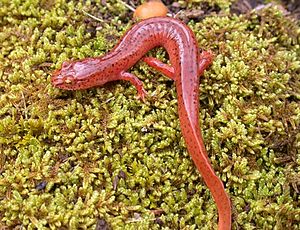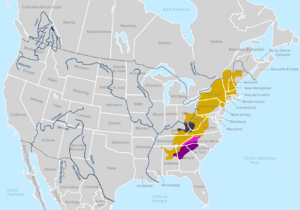Spring salamander facts for kids
Quick facts for kids Spring salamander |
|
|---|---|
 |
|
| Conservation status | |
| Scientific classification | |
 |
|
| Range of Gyrinophilus porphyriticus subspecies: Brown: G. p. porphyriticus |
|
| Synonyms | |
|
The spring salamander (Gyrinophilus porphyriticus) is a type of salamander found in Canada and the United States. It belongs to the family called Plethodontidae, which are salamanders without lungs. The name Gyrinophilus means "tadpole lover," because these salamanders spend a long time as gilled larvae (like tadpoles) before they grow up. The name porphyriticus comes from a Greek word for a purple stone, which is why this salamander is sometimes called the purple salamander.
Spring salamanders live in cool, wet places like temperate forests, rivers, swamps, and freshwater springs. They can also be found in caves. They eat insects, worms, and other small creatures without backbones. Bigger spring salamanders might even eat smaller salamanders, like two-lined or dusky salamanders. In some areas, like the mountains of North Carolina, other salamanders can make up a large part of their diet.
Even though cutting down forests can be a problem for them, spring salamanders live in many protected areas. They are not considered an endangered species on the IUCN Red List.
Contents
Appearance
Like all salamanders in their family, spring salamanders have a special groove between their nose and upper lip called a nasolabial groove. This helps them sense things around them.
The northern and Kentucky spring salamanders can grow to be about 12 to 19 centimeters (4.75 to 7.5 inches) long. The longest one ever found was about 23 centimeters (9.125 inches) long! They have a light line from their eye to their nostril, sometimes with gray coloring below it. Their back can be salmon-colored, light brownish, pink, or reddish. The colors often look cloudy, and darker markings are usually faint.
The Blue Ridge and Carolina spring salamanders can be about 13 to 19 centimeters (5 to 7.5 inches) long. The longest one found was about 20 centimeters (8.06 inches). Salamanders living in higher places tend to grow larger because they take longer to become adults. These salamanders have a clear white line from their eye to their nostril, often with a dark line below it. They might also have a dark line above the white one. Their back can be clear reddish, salmon, or orange-yellow, with black or brown spots or flecks. They have 17 to 19 grooves along their sides.
Young spring salamanders (larvae) live in water and look like stream creatures. Younger salamanders are usually brighter in color than the adults.
Home and Habitat
You can find spring salamanders in cool mountain springs and other wet spots. They often hide under logs, stones, or leaves in the surrounding forest. They need places with enough oxygen and moisture because they breathe through their skin.
During colder months, these salamanders stay in wet soil near water sources. They remain somewhat active in burrows or in the leaf litter close to a stream or other body of water.
Where They Live
Spring salamanders live from southern Quebec in Canada down to northern Alabama and the very northeast part of Mississippi in the United States. There's also a small group living in Hamilton County, Ohio.
Different types of spring salamanders live in different areas:
- The Kentucky spring salamander is found in southern Ohio, eastern Kentucky, West Virginia, and western Virginia.
- The Blue Ridge spring salamander lives in the southern Appalachian Mountains and nearby areas from North Carolina to Alabama.
- The Carolina spring salamander is found in the southern part of the Blue Ridge area and nearby regions from southwest North Carolina to eastern and central Alabama.
- The northern spring salamander lives in all the other parts of the species' range.
Reproduction and Life Cycle
Spring salamanders usually breed in late summer and fall. The male and female perform a special courtship dance. The male slides his head over the female's body. Then, the female walks over the male's tail. The male then places a packet of sperm, called a spermatophore, on the ground. The female picks it up and stores it until she is ready to fertilize her eggs. After placing the spermatophore, the male walks forward with his tail standing straight up, wiggling it so the base of his tail touches the female's chin.
Females lay their eggs in the summer after mating. The eggs are sticky, which helps them stick to surfaces. A female can lay anywhere from 16 to 160 eggs. She will guard the eggs until they hatch, usually in late summer or early fall. After hatching, the young larvae might stay near their mother, but they don't depend on her directly.
Spring salamander larvae stay in their larval stage for several years, sometimes up to four years. After they change into adults (metamorphosis), it takes them another four years to become old enough to reproduce themselves.
Predators and Enemies
Fish are the main predators of spring salamanders, especially the Brook trout (Salvelinus fontinalis). If brook trout are present, the survival rate of young spring salamanders can drop by more than half. The growth of spring salamanders is also much slower in areas where they live with brook trout.
Other animals that might eat spring salamanders include the Eastern Garter Snake (Thamnophis sirtalis) and the Northern Water Snake (Nerodia sipedon). Spring salamanders can also release a toxin through their skin to try and scare off predators.
Conservation Status
The IUCN Red List says the spring salamander is of "least concern," meaning it's not currently in danger of disappearing. The United States government also doesn't list it as a threatened species.
However, in some states like New Jersey, Connecticut, Mississippi, Massachusetts, Rhode Island, and Texas, the spring salamander is listed as threatened. In these areas, their main threats are cutting down forests, farming, and the introduction of fish like trout for sport fishing.
In Québec, Canada, the Adirondack / Appalachian population of spring salamanders has been listed as threatened since 2017 under the Species at Risk Act.
Subspecies
- Northern spring salamander (Gyrinophilus porphyriticus porphyriticus)
- Kentucky spring salamander (Gyrinophilus porphyriticus duryi)
- Blue Ridge spring salamander (Gyrinophilus porphyriticus danielsi)
- Carolina spring salamander (Gyrinophilus porphyriticus dunni)



